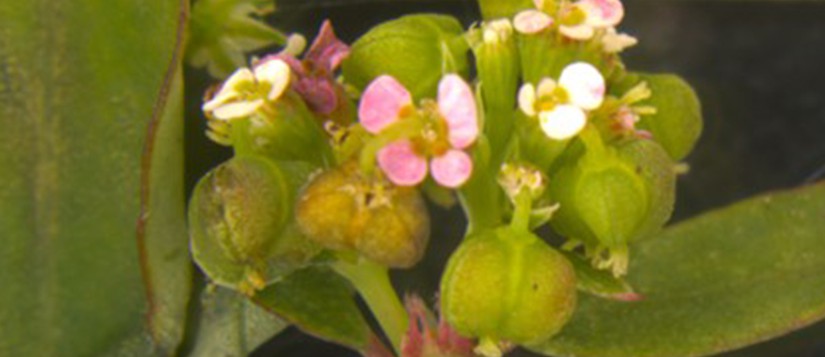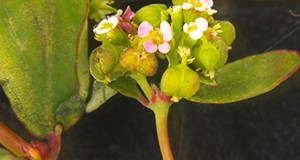Graceful sandmat (Chamaesyce hypericifolia) is a problematic weed that often grows in container media in ornamental plant nurseries. This 4-page facts sheet profiles the biology of graceful sandmat and recommends physical, cultural, and chemicals methods for managing the weed in the nursery environment. Written by Theresa Chormanski, Chris Marble, and Lyn Gettys, and published by the UF Department of Environmental Horticulture, June 2015.
http://edis.ifas.ufl.edu/ep522
Tag: Euphorbiaceae (taxonomic family)
Hippomane mancinella, Manchineel (FOR302/FR370)
 This poisonous tree is native to southern Florida, the Keys, many of the Caribbean islands, Mexico, and Central America. Though it is poisonous to humans and many animals, iguanas are eat the fruit and sometimes live among the tree’s limbs. It’s found along the seacoasts and in brackish swamps where it grows among mangroves. Each leaf has a small gland where the leaf joins the stem. The bark is reddish-to-grayish brown and cracked looking. Flowers inconspicuous, but the spikes or leafless stems that the flowers emerge from are visible. The fruit is bright-green and looks like a small apple. This 2-page fact sheet was written by Michael G. Andreu and Melissa H. Friedman, and published by the UF Department of School of Forest Resources and Conservation, July 2012.
This poisonous tree is native to southern Florida, the Keys, many of the Caribbean islands, Mexico, and Central America. Though it is poisonous to humans and many animals, iguanas are eat the fruit and sometimes live among the tree’s limbs. It’s found along the seacoasts and in brackish swamps where it grows among mangroves. Each leaf has a small gland where the leaf joins the stem. The bark is reddish-to-grayish brown and cracked looking. Flowers inconspicuous, but the spikes or leafless stems that the flowers emerge from are visible. The fruit is bright-green and looks like a small apple. This 2-page fact sheet was written by Michael G. Andreu and Melissa H. Friedman, and published by the UF Department of School of Forest Resources and Conservation, July 2012.
http://edis.ifas.ufl.edu/fr370
FOR244/FR306 Ricinus communis, Castor Bean
FOR241, a 2-page fact sheet by Melissa H. Friedman, Michael G. Andreu, Heather V. Quintana, and Mary McKenzie, describes this small statured tree from northeastern Africa and the Middle East, which is abundant throughout Florida. – scientific and common names, description, allergen, storm tolerance, and applications. Includes references. Published by the UF School of Forest Resources and Conservation, May 2010. http://edis.ifas.ufl.edu/fr306
HB003 Stinging Nettles of Florida: Cnidoscolus
HB003, a 2-page illustrated fact sheet by Wendy B. Zomlefer, describes this perennial herb with stinging hairs, milky sap, and tuberous roots — its classification, description, similar species, and toxicity. Includes references. Published by the UF Herbarium, October 2008.
http://edis.ifas.ufl.edu/HB003

